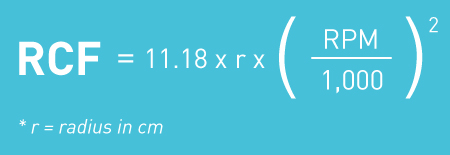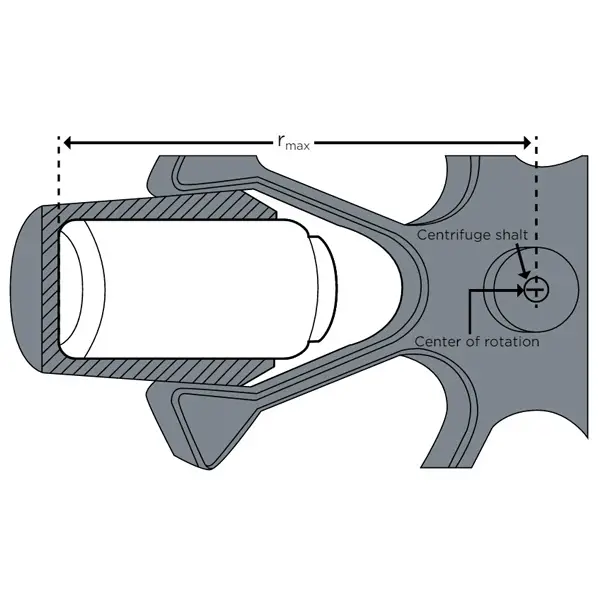Table of Contents
When working with centrifuges you’ll encounter two different measurement units that are called the Relative Centrifugal Force (RCF) and the number of revolutions per Minute (RPM). It is essential to be aware of the fact that they are both different. If they are not used correctly (which isn’t as rare as you believe) and the test will be destroyed. Let’s look at the RCF as well as RPM in greater detail , and then determine whether there is any connection between them.
How Centrifuges Work?
Centrifuges function by putting your samples into rotation about a fixed point which causes an accelerative force that is perpendicular to the axis, as illustrated in the diagram to the right.
Of course this force causes the particles within the sample to accelerate to the edge of the rotating rotor. It is convenient for centrifuge makers to make their centrifuges to ensure that the bottoms of the tubes is located close to the outside of the rotor. This force of the centrifuge causes dispersal of particles from your sample down to the bottom of the tube.
The force needed for a piece of material to be moved varies on the dimension of particle. Large particles (e.g. cell) need less strength than smaller particles (e.g. precipitated proteins). For more information about this, take peek at these Wikipedia articles about sedimentation and how to solve the Lamm equation.
Revolutions Per Minute (RPM)
RPM stands for Revolutions Per Minute. (RPM) regarding centrifugation is a measure of the speed with which the centrifuge’s rotor can make an entire rotation within one minute. It basically tells us the speed at which the rotor is turning. Centrifuges can be found in a range they are capable of reaching and can differ based on the type of centrifuge. A centrifuge that is low-speed could spin as little as 300 RPM, whereas the high-speed centrifuge can be able to spin at 15000 RPM. Ultracentrifuges also exist as the strongest form of centrifuge. They are able to spin more than 150,000 RPM.
Relative Centrifugal Force (RCF)
A Relative Centrifugal Force (RCF) or the g-force (both is the exact same thing, RCF is expressed in grams of gravity) is a measure of the gravitational force the sample is exposed to. The force is created by the rotor spinning whichin turn releases this force to the outside of the tube of centrifuge. It is not just that RCF consider its speed but it also determines the distance to the centre of rotation in order to determine a g force measurement. RCF is the most preferred method of measurement since it is the same regardless of whether you use an alternative centrifuge that has an entirely different size of rotor.
What’s the difference between RPM and RCF centrifugation?
Both RCF/g force and RPM/g can be measured using centrifugation, but as we’ve looked at, the two differ in a significant way. RPM is a measure of how fast the rotor spins and while this information can be useful but it does not have the ability to determine the amount of g the sample is exposed to. A centrifuge running at 5000 RPM for instance, would be spinning at 5000 RPM regardless of the type of centrifuge employed and the dimensions of the rotating rotor. RCF incorporates the size of the rotor into its measurement to ensure that we can calculate the gravitational force that is being applied. This is why it is important to always record your processes in G’s instead of RPM.
It could be that your centrifuge has the option of setting RPM. If that’s the case, then you’ll need to utilize a formula to convert RCF to RPM, which is described below. If you’re currently looking for a centrifuge, you should try for one that can measure both RCF and RPM, in order to avoid having to convert them manually. The majority of modern centrifuges include this capability so that it is possible to change between them interchangeably. This formula allows the conversion of RPM into RCF, however the problem in applying this calculation is you need to calculate the radius. Typically, the company that makes the rotor will give three radius numbers which are the minimum, maximum and the average. These are the distances from both the bottom, top and middle of the centrifuge tube, from the center of the centrifuge tube.

It is essential to be aware of the distinction in RCF and RPM since it could result in a catastrophe when you do not know the difference. Always be able to report the results you get in RCF because this will remain constant regardless of the type of centrifuge you’re using. Two different centrifuges operating at the same speed could have a totally distinct RCF measurement. The best way to be sure that you’re recording the RCF accurately is using a centrifuge that you can define the RCF of your experiment.
How to calculate the centrifugal field strength?
There’s a straightforward formula to determine the force of a specific centrifugal force:
where r is the radius where r is the measurement of an amount of millimeters (mm) from the center of rotation to a point inside the rotor and RPM refers to the speed of the rotation in units of revolutions per minute (rpm). Some times, distances radial are stated in centimeters. Before you use these in this equation it is necessary to convert them into millimeters (multiply by 10).
How to determine maximum RCF of a centrifuge rotor?
To calculate the RCF maximum of the rotor, it is necessary to determine its maximum speed as well as it’s maximum radius (rmax) and also that distance between the centre of rotation and the top of the rotor’s bucket or cavity when centrifugation is taking place (see below for an illustration). Most centrifuge makers provide this information on their rotors in their instructions manuals.

For instance, the highest RCF for the JS-4.2 Rotor is determined from its highest rate (4200 RPM) and its Rmax (254 millimeters) in the following manner:

If the same rotor was operating at a lower speed like 2000 rpm, the RCF generated by it will be less:

Because the RCF is dependent on how much the square is of rotor’s speed, you can observe that any speed change can cause a greater variation in RCF.
Converting RPM to RCF
Because benchtop centrifuges are typically offered with speed settings in RPM, it’s vital for researchers to learn the method of converting RPM into RCF. To accomplish this, you must use this equation
g = (1.118 x 10-5) x R x S2
The equation g is referring to the force of centrifugal relative The radius is defined as the radius the rotor has in centimeters as well as S, the speed, in revolutions per minute (RPM).
Although the formula is useful but it can also be laborious. There are a number of other methods to convert RCF to RPM. This includes:
- A nomogram, also known as a graphic calculator, which can calculate the right speed for the centrifuge rotor in order to attain the desired RCF. It also provides an accurate estimation for centrifugation with low speed.
- A calculator online that can be found at Insilico, Hettich, and Encore Bio.
- Online resources and websites like Gene Infinity and Science Gateway that produce more precise outcomes.
References
- https://www.mybeckman.in/resources/technologies/centrifugation/principles/relative-centrifugal-field
- https://www.westlab.com/blog/2019/01/29/difference-between-rcf-and-rpm-in-centrifugation
- https://camblab.info/what-is-the-difference-between-rcf-and-rpm-in-centrifuges/
- https://blog.btlabsystems.com/blog/what-is-rcf
- https://bitesizebio.com/1777/rpm-does-not-equal-rcf/
